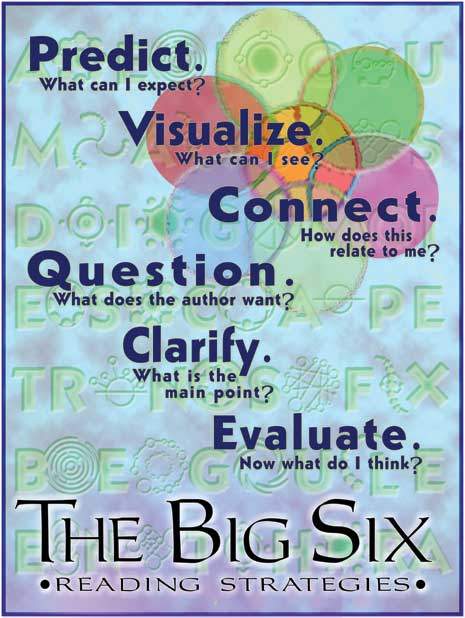Lesson Plan: Critical Thinking Through Storytelling
by Sarah Sahr
 When I was teaching Grade 8 just outside of Baltimore, Maryland, USA, my school district required all English teachers to teach “The BIG 6.” We even got a poster to hang on our wall. Basically, The BIG 6 was just a new approach to critical thinking. So, as to not keep you in suspense, The BIG 6 are:
When I was teaching Grade 8 just outside of Baltimore, Maryland, USA, my school district required all English teachers to teach “The BIG 6.” We even got a poster to hang on our wall. Basically, The BIG 6 was just a new approach to critical thinking. So, as to not keep you in suspense, The BIG 6 are:
- Predict (what can you expect?)
- Visualize (what can you see?)
- Connect (how does this relate to me?)
- Question (what does the author want?)
- Clarify (what’s the main point?)
- Evaluate (now, what do I think?)
How many of you have heard of these before? Here’s a quick storytelling lesson plan to put The BIG 6 into action.
| Materials: Starter pictures (enough for each group of students), a story, The FINAL 3 handout (.docx) |
| Audience: All ages, all levels |
| Objectives: Students will be able to distinguish between the six primary reading strategies; students will demonstrate understanding of when to use each one effectively and efficiently |
| Outcome: As a class, students will be able to reflect upon on a short story by providing personal insight and evaluation |
| Duration: One 50-minute class period |
To showcase my use of The BIG 6, I’ll use the well known story, Cinderella. However, depending on your students’ age and language proficiency, you might want to use something more challenging. I’ve always wanted to use “The Hunting of the Snark” by Lewis Carroll, but haven’t found the right time or class.
Predict
Divide the class into several groups. Make sure the groups have no more than four students. Write the words: party, magic, family, dancing, curfew, and cat, on the board. Have students talk with each other about what these words might mean and how a story could be situated around them. If students are unclear of the meanings, make a teachable moment of it and have students help each other out. When ready, solicit predictions from the class.

Click image for printable PDF:
large file (2MB) suitable for enlargement
Visualize
For the sake of Cinderella, I would bring in photo cards of a beautiful dress, a pumpkin, mice, a carriage, and an angry mother. Make enough sets of cards for each group. Continuing with the predicting task, have students arrange the photos in a way the story might unfold.
Read the Story
Notice, the version of Cinderella I’ve provided a link to is very short. Short stories work best. You can read aloud and ask the students to close their eyes and visualize what is happening (but note that then this becomes a listening activity). Or, you can hand out copies of the story to the class. It’s up to you!
Continuing with “Visualize,” have students talk about the images they saw when they were listening to the story.
Connect
Ask students to think about how this story might relate to their lives. From the groups, pair students up, so that now our groups of four are partners of two. Have students discuss, in their pairs, some of the things they thought about. Lastly, have all pairs share their thoughts with the class.
Question, Clarify, and Evaluate
The last three parts of The BIG 6 are Question, Clarify, and Evaluate. I think it’s easiest to put these three together in a small handout. This table can be printed on half sheets of paper, and the sections can be adjusted with more complex tasks for higher level students. Go over each section with the class.
Question
Have students write down their thoughts on what the author is trying to say. Or, students can write down some of the questions they still have in regard to the story.
Clarify
This is a chance for students to answer each others’ questions. Also, this is a great opportunity to make sure students have found the overarching theme of the Cinderella story (even though students may not agree with each other, it’s a great talking point for the class). As a teacher, now is a good time to walk about the room and check proficiency levels. Try not to intervene. Let students carry on their conversations without much guidance.
Evaluate
This last one is easy… what did students think of the story? Many of them may already be familiar with the story, so this might be too easy in some cases. That is why choosing a different story might be best for your class. The point is to have fun with it!
____________________
Sarah Sahr works at TESOL and is currently pursuing her doctorate in education administration and policy at the George Washington University. Her professional career has taken her all over the world, most notably as a Peace Corps volunteer in Ethiopia and as a traveling school teacher/administrator with Ringling Bros. and Barnum & Bailey circus. Sarah is also a certified ashtanga yoga instructor and has managed an eco-lodge in Chugchilan, Ecuador.
TESOL Blogs
Interested in writing a blog for TESOL?
Contact
Tomiko Breland with your idea or for details.
Check out the latest TESOL Blogs:
|
The Right Placement for ESL Writers, by Elena Shvidko
 In today’s entry, I would like to address the issue of the placement of international students in college composition classes. As we all know, institutions of higher education in the United States host a large number of international students drawn from a wide range of countries. This number is increasing each year. “Today universities are among the most diverse organizations in the world” (Harrison, 2012, p. 224). Along with the benefits that foreign learners obtain from pursuing their education in U.S. colleges, they also encounter challenges of linguistic, educational, financial, social, cultural, and psychological origins. Read More. In today’s entry, I would like to address the issue of the placement of international students in college composition classes. As we all know, institutions of higher education in the United States host a large number of international students drawn from a wide range of countries. This number is increasing each year. “Today universities are among the most diverse organizations in the world” (Harrison, 2012, p. 224). Along with the benefits that foreign learners obtain from pursuing their education in U.S. colleges, they also encounter challenges of linguistic, educational, financial, social, cultural, and psychological origins. Read More.
|
|
Bridging the Gap Between Research and Classroom Practice, by Deena Boraie, TESOL President
 In an interesting article in the Guardian Weekly of October 16, 2012 (“How Useful is TESOL Academic Research?“), Penny Ur asks an important question about TESOL academic research for classroom teachers. She acknowledges the gap between classroom practice and research, stating that the source of professional learning for most teachers is from their classroom experience and interaction with students as well as discussions with their colleagues. Teachers are busy people and have little time to read research. She notes that a lot of the research focuses on language acquisition and rarely deals with pedagogical issues such as effectiveness of different types of exercises or classroom management. Read More. In an interesting article in the Guardian Weekly of October 16, 2012 (“How Useful is TESOL Academic Research?“), Penny Ur asks an important question about TESOL academic research for classroom teachers. She acknowledges the gap between classroom practice and research, stating that the source of professional learning for most teachers is from their classroom experience and interaction with students as well as discussions with their colleagues. Teachers are busy people and have little time to read research. She notes that a lot of the research focuses on language acquisition and rarely deals with pedagogical issues such as effectiveness of different types of exercises or classroom management. Read More.
|
|
Google+ Education: Part 2, by Tara Arntsen
 Back when I talked about participatory cultures in a post entitled Moving Education Online, I mentioned Google Sites as a resource for teachers. Google Sites is great because you can easily make a class website using the template called Classroom site. While building a website from scratch is intimidating for many, creating a website from this Google Sites template is not hard as there are directions for customizing the various sections. Some sections included in the template are homework assignments, contact me, class announcements, reading list, class photos, and word of the week. If you don’t need a section, just delete it! It’s that simple. Read More. Back when I talked about participatory cultures in a post entitled Moving Education Online, I mentioned Google Sites as a resource for teachers. Google Sites is great because you can easily make a class website using the template called Classroom site. While building a website from scratch is intimidating for many, creating a website from this Google Sites template is not hard as there are directions for customizing the various sections. Some sections included in the template are homework assignments, contact me, class announcements, reading list, class photos, and word of the week. If you don’t need a section, just delete it! It’s that simple. Read More.
|
TESOL Bookstore

 Treat Yourself to a Book Full of Surprises!
Treat Yourself to a Book Full of Surprises!
Language Teaching Insights
From Other Fields:
Sports, Arts, Design, and More
This book is a fun read and full of practical tips from language teachers who bring their insights to the classroom from extensive experience in other fields.
How would a restaurant reviewer critique an essay? How would a martial arts master facilitate language practice? How would a bartender create a supportive environment for learning? And how would a social activist promote critical thinking in the classroom? Answers to these questions and more translate into new ways of thinking about teaching and the classroom.
"The authors provide much, much more than the “insights” promised in the title. Each chapter is fascinating, inspiring, refreshing, and intellectually stimulating. I would select it for an ESOL methods course. Buy this book!" (John F. Fanselow, Professor Emeritus, Columbia University Teachers College)